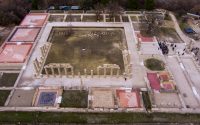With Minimal Representation from the Global South, Paris+ Considers Its Selection Process in Second Edition
For the second edition of Paris+ par Art Basel, the fair’s leadership placed deliberate emphasis on refining its offerings, from the overall look and feel to accessibility.
“We launched last year in a short span of time – 9 months, we rushed, passionately, but may have overlooked some things,” fair director Clément Delépine told ARTnews. This year, however, the emphasis was on raising the fair to Art Basel standards and deepening its connection to the French capital.
While Paris+ is meant to be a “tour” of the market, Delépine said, it should also sit at the intersection of the French scene and art and culture internationally. To achieve this, organizers introduced more public-focused programming, like collaborations with esteemed institutions like the Centre Pompidou and its public art exhibition at the Tuileres Garden, a contrast from last year’s Site section, which focused on large-scale installations.
“It felt like Art Basel was just parachuting outward in the public space and we wanted to transition.” Delépine said.
As Paris+ aims to integrate into the French system—its galleries and foundations—Delépine and Art Basel’s leadership are still wrestling with questions of representation for the fair. In this year’s edition, only three Africa-based galleries are participating out of 154 exhibitors: SMAC in Capetown, Cécile Fakhoury with operations in Dakar and Abidjan, and Selma Feriani in Tunis. Comparatively, in 2019, FIAC, a long-running competing fair that was displaced by Paris+’s arrival last year, featured two Africa-based galleries.
“We are aware that the galleries of Africa are under-represented in the exhibitors list,” Delépine said of the disparity, before adding that the fair is still navigating the inherently exclusionary nature of the selection process.
Feriani told ARTnews that the small number of galleries with bases on the African continent at Paris+ comes down to several factors: contemporary art is historically still nascent in many African locales; galleries in Africa tend to be commercially oriented and consignment-based and less focused on creating ties with institutions; and, lastly, Art Basel is a highly selective franchise.
Paris+, like many major fairs, has a rigorous selection process, where galleries are judged by their peers. The fair has a seven-person selection committee with dealers based in the US and Europe, who evaluate candidates based on exhibition histories, their ability to support artists, location, and their potential to “elevate the overall quality of the fair,” Delépine said. However, the director added that the fair has been looking at how to create a more flexible approach to facilitate emerging galleries transitioning to the general sector where transactions happen at the highest level. For example, he suggested the committee look more at a gallery’s project development rather than just how long it has been operating in a particular locale. Reflecting on the fair’s geographic representation, Delépine acknowledged the challenges faced by galleries from Africa and the Global South, pointing out that Art Basel has been paying closer attention to the “fragile economies” suffered by younger galleries in its Galeries Émergentes section.
Feriani opened her exhibition space, a converted convent, in post-revolution Tunisia in 2013, when artists and creative types started gravitating towards public spaces for demonstrations and cultural dialogue. This year, she is working to establish a residency program in Tunis that act as an “incubator” for artists. The gallery’s program leans towards conceptual art, collaborating often with artists exploring the impacts of colonialism in their regions. At Paris+, her presentation is focused a group of her roster’s top names, including Massinissa Selmani, an Algerian artist nominated this year for France’s prestigious Marcel Duchamp Prize, and whose work bears influence from Surrealism. Paris holds significant institutional importance for the gallery, Feriani said. “It’s an important platform for us.” Delépine described Feriani as “a force to be reckoned with.”
SMAC Gallery and Cécile Fakhoury also emphasized their commitment to promoting artists with strong conceptual foundations that can compete with museum shows. Operating since 2008, Capetown’s SMAC Gallery additionally runs an artist residency program. For its booth at Paris +, it is exhibiting sculptural work by South African artist Simphiwe Buthelezi, who is still in her twenties. Meanwhile, Fakhoury, who has been operating since 2012, has been vocal about increasing the share of African-based collectors who back her roster of artists, making sure that base is not outpaced by collectors in the West.
In an interview with ARTnews Fakhoury said that the gallery’s presence in France is key to their program’s development. “Enhancing the visibility of the original gallery in Abidjan,” Fakoury said, is the primary goal. For its presentation, Fakoury wanted to bring exposure to the work of the young artist Elladj Lincy Deloumeaux, who was born in Guadaloupe and already has a following in Europe. Before the fair, she had been developing ties with the artist for several months, bringing him to the gallery’s residency in Grand-Bassam, Côte d’Ivoire.
“There were always contemporary art scenes in African cities and countries, but it wasn’t visible on a global stage because we lack an ecosystem for the arts, with more public structures such as museums. As far as West Africa is concerned, I think the situation can evolve from both sides,” Fakoury added. International fairs may take more notice in the future, she added, that there is renewed attention on African modern movements stemming the practices of artists associated with the Ecole de Dakar in Senegal, and the Vohou-Vohou movement in Abidjan, both in the 1960-1970s.
Still, Feriani said she has embraced the fair’s strictness as a high standard for intellectual projects, emphasizing the need to bring artists who are considered authorities in their home regions. She spoke of the artists she backs as being akin to cultural ambassadors, many of them working with historical archive and facilitating exchanges that she says needs to be further mutually developed between European art figures and parts of the Global south.



